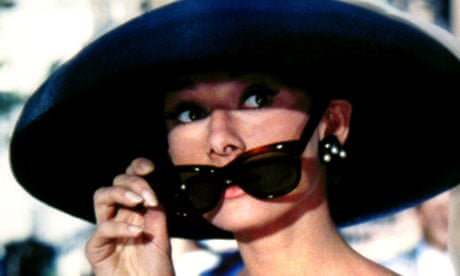To admit that Breakfast at Tiffany's is one of your favourite films, these days, is to out yourself as the emotional and intellectual equivalent of a cupcake. The iconography of Audrey Hepburn as Holly Golightly has become as neatly packaged and commodified as a duck-egg blue Tiffany's box – a world away from Capote's booze-and-nicotine-fuelled 1958 original. A revisionist feminist take on Breakfast at Tiffany's would be as unconvincing and ill-advised as Mickey Rooney playing the Japanese Mr Yunioshi – there's no getting away from the fact (although Hollywood tried) that Holly takes money "for the powder room", and that she is in many ways the creation of a series of Svengali-like men.
And yet, how many cinematic heroines can you think of who are truly free-spirited – however wounded and vulnerable – rebels? Fellow southern belle Scarlett O'Hara had similar grit and would surely have taken New York by storm had she been born in a later age, and decades later Thelma and Louise launched themselves into a hopeless future with the same reckless abandon, but in between there are few such dazzling female characters as Holly. And for the most part, in the film at least, she gives the rats and super-rats a good run for their money.
From the

opening credits to the lingering final shot, the film is all about Holly – or, more precisely, Audrey. For once the love interest is a man, and he isn't even that interesting. Despite this being his only memorable role (the, ahem, A-Team notwithstanding), George Peppard is as smooth and bland as a bar of soap: the cat has more personality. The other characters (like the addition of 2E, played by Patricia Neal, to make everyone feel a little more comfortable with Holly's means of making a living) are mere foils or props for the heroine. But this, like so much else (apart, of course, from the ending) is faithful to Capote's original: the unnamed writer narrator, remember, has no story of his own to tell until he meets Holly.
The film is the sparkling champagne to the novella's dirty martini (which led Mailer to crown Capote "the most perfect writer of my generation"), and each have their distinct pleasures. Where the mean reds smoulder dangerously at the edges of the pages, like Capote's endless cigarettes, the film is drenched in sunshine (we know it's not far away even in the final downpour). Although there are dark moments: anyone who can keep a dry eye as Paul regretfully closes the door on a desperately grieving Holly has a heart of "cold macaroni".
H

olly's determination to put a brave face (full make-up, darling, even in bed) on things makes her an old-fashioned heroine. Give a girl lemons and she'll make a martini. As her name card says, she goes lightly: who hasn't dreamed of just putting "Travelling" in their out-of-office message? In the opening scene, from our first glimpse of her through the doorway in eye-mask, tasselled earplugs and man's dinner shirt, to the alligator shoes and trademark sunglasses of the final transformation for her trip to Sing Sing, Holly is all about dressing up. Holly/Audrey has become synonymous with the little black dress, but what the LBD stands for is wearing something that means, no matter what you're feeling inside, you can face the world with confidence.
But it isn't just that dress. New York – which undoubtedly looks great – is a catwalk for Holly/Audrey's much-imitated wardrobe. The orange coat and bucket hat combo she wears on her day out with Paul; the Burberry-style mac to see Doc off at the bus station; and never has a woman made a turtle-neck look so effortlessly desirable. Holly is the ultimate material girl; like Madonna constantly reinventing herself. As OJ Berman says, in just one of the exchanges lifted straight out of the book (sadly, I can quote a lot of them): "She is a phony. But… she isn't a phony because she's a real phony." It is this real phoniness – as well as Holly's warmheartedness — that the film captures so well.
Capote was very specific as to Holly's sartorial tastes. "She was never without dark glasses, she was always well groomed, there was a consequential good taste in the plainness of her clothes, the blues and greys and lack of lustre that made her, herself, shine so." Hepburn, in other words, who shines as if lit from within: the only thing on which director Blake Edwards strayed was the leading lady's hair colour. Famously, Capote wanted Marilyn Monroe for the role – thank goodness she turned it down. Breakfast at Tiffany's with cleavage would be an altogether different film. Legendarily beautiful and sophisticated, Hepburn might at times be a clothes horse, but she's never a sex object and this is not a story about sex. (That's just how Holly – and Paul – pay the bills.)
Sometimes characterised as a "female Gatsby", Holly, to me is rather closer to Nancy Mitford's Linda Radlett from The Pursuit of Love: two fatally "lop-sided romantics", who guard their freedom as fiercely as they give their heart away easily. (And, most importantly, neither is ever a bore.) In the harsh black-and-white world between book covers, they pay the price for their dreams of finding both love and independence.
And so to the Hollywood ending. But close readers of the novella need not be outraged: the director only took the liberty of making the narrator's final vision – of the cat, and Holly, finally at home – a reality. The novella is all about escape and the film is escapism at its best. When my own world starts taking on an a mean tint, playing it can be as reassuring as a trip to Tiffany's. And no – I don't watch it eating a box of chocolates and painting my nails. But I might cry – a little.

Comments (…)
Sign in or create your Guardian account to join the discussion